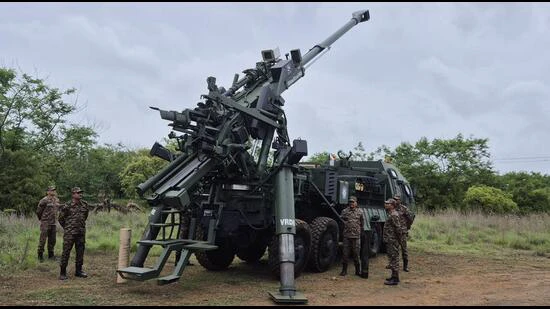AHMEDNAGAR: The Indian Army is set to conduct trials to assess the performance of a locally made mounted gun system that can shoot and scoot in 85 seconds — a capability that allows the 30-tonne weapon to swiftly relocate and evade counter-battery fire, senior Defence Research and Development Organisation (DRDO) officials said on Monday.
The army has written to the DRDO’s Ahmednagar-based Vehicles Research and Development Establishment (VRDE), asking it to make the mounted gun system (MGS) available for extensive trials in different terrains and weather conditions, VRDE chief GRM Rao said at a briefing on the weapon’s capabilities and how it stacks up against similar systems in service worldwide including French Caesar and Israeli ATMOS 2000 systems.
The MGS is a 155mm/52 calibre truck-mounted howitzer that can fire six rounds in a minute and hit targets more than 45 km away. Here, 155mm denotes the diameter of the shell and calibre relates to barrel length.
The MGS is based on the indigenous advanced towed artillery gun system (ATAGS), already ordered by the defence ministry to boost the army’s firepower. In March, the defence ministry signed two contracts worth ₹6,900 crore with Bharat Forge Limited and Tata Advanced Systems Limited for 307 locally made ATAGS along with high mobility towing vehicles.
“The MGS performed well during internal trials by VRDE at Balasore and Pokhran. It meets the qualitative requirements laid down by the army. The Russia-Ukraine war has shown the effectiveness of high mobility artillery,” said Rao, referring to truck-mounted Caesar guns deployed by Ukraine in the war. The internal trials saw the MGS fire more than a hundred rounds.
DRDO has developed the MGS and transferred technology to Bharat Forge Limited for production. The army needs 700 to 800 such guns with enhanced mobility and superior firepower. The defence ministry floated a tender two years ago for 300 mounted gun systems and the firms competing for the order include Bharat Forge Limited, Tata Advanced Systems Limited, Adani Defence and Aerospace (in partnership with an Israeli firm) and Advanced Weapons Equipment India Ltd (a defence public sector undertaking), HT learns.
The upcoming evaluation of the DRDO-Bharat Forge gun by the army is not under the competitive bidding process initiated by the ministry in 2023 but a parallel testing of the MGS, said another senior DRDO official, adding it has an indigenous content of up to 85%. It will go in for trials again as part of the competitive bidding process.
“The ATAGs is already on order and the MGS is the same gun system mounted on an 8X8 wheeled vehicle with shock absorbing stabilisers, blast resistant armoured cabin, on board silent electric power system and integrated electronic controller. The testing of MGS by the army before the field trials involving other competitors is expected to give it a head start,” the second official said.
The ATAGS order was split between Bharat Forge Limited, which emerged as the lowest bidder for the tender and will manufacture and supply 60% of the guns, while the remaining 40% will be produced by Tata Advanced Systems Limited. ATAGS will replace the vintage and smaller calibre guns held by the army.
The DRDO began the ATAGS project in 2013 to replace older army guns with a modern 155mm artillery gun system. It partnered with the two private firms to manufacture the gun.
High mobility artillery is a technology gap which needs to be addressed, said a third official. “The MGS is a viable solution. The advantage of this system is that it can be rapidly deployed and matches the mobility of mechanised forces. It can destroy enemy targets and move out before retaliatory fire takes place. Adding mobility to artillery guns enhances their lethality and firepower,” he added.
In December 2024, the defence ministry signed a ₹7,629-crore contract with Larsen & Toubro for 100 more self-propelled K9 Vajra-T guns that are being manufactured locally with technology transfer from South Korean firm Hanwha Techwin. That was a repeat order for the K9 Vajra-T guns — the army has so far inducted 100 such guns under a 2017 contract.
The army plans to enhance its firepower, with a greater emphasis on mobility, precision attacks, range, quick strikes and survivability as it ramps up efforts to buy an array of weapons, including guns, rocket systems and missiles.
The linchpin of this capability boost, which will cost tens of thousands of crores, is a five-pronged strategy evolved after an assessment of what the artillery regiments need for battlefield supremacy. The strategy hinges on equipping all regiments with advanced 155mm artillery gun systems, inducting missiles and rockets with longer ranges and precision, lethal ammunition, reorganisation of surveillance and target acquisition units, and shortening the sensor-to-shooter loop for swift detection and destruction of targets.
The army has drawn some lessons from the Russia-Ukraine war. These include the need for deployment of more self-propelled and mounted gun systems for improved mobility, missiles and rockets with superior range, ensuring increased survivability against the enemy and optimising the use of drones.
All gun systems bought during the last five to six years (and those in the process of being procured) to enhance the artillery’s lethality, reach and versatility are indigenous except the M777 ultra-light howitzers that were imported from the US.
